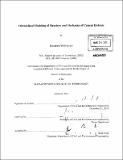| dc.contributor.advisor | Franz-Josef Ulm. | en_US |
| dc.contributor.author | Shahsavari, Rouzbeh | en_US |
| dc.contributor.other | Massachusetts Institute of Technology. Dept. of Civil and Environmental Engineering. | en_US |
| dc.date.accessioned | 2011-06-20T15:52:23Z | |
| dc.date.available | 2011-06-20T15:52:23Z | |
| dc.date.issued | 2011 | en_US |
| dc.identifier.uri | http://hdl.handle.net/1721.1/64567 | |
| dc.description | Thesis (Ph. D.)--Massachusetts Institute of Technology, Dept. of Civil and Environmental Engineering, February 2011. | en_US |
| dc.description | "February 2011." Cataloged from PDF version of thesis. | en_US |
| dc.description | Includes bibliographical references (p. 236-251). | en_US |
| dc.description.abstract | With an annual production of more than 20 billion tons a year, concrete continues to be the world's dominating manufacturing material for a foreseeable future. However, this ubiquity comes with a large ecological price as concrete stands as the third largest culprit to the torrent of CO2 after transportation and electricity generation. Despite several decades of studies, fundamental questions are still unsettled on the structure and properties of the smallest building block of concrete, Calcium- Silicate-Hydrate (C-S-H). Given the variable stoichiometry and morphology of C-S-H, no accurate models were ever developed that could link electronic information at one end to the C-S-H molecular properties at the other end. This thesis develops a new modeling toolbox that enables unraveling the interplay between structure, composition, morphology and mechanical properties of this "liquid stone" gel. First, using ab-initio calculations we characterize the structural and mechanical properties of several mineral analogs of CS- H (tobermorite family and jennite). We show tobermorite as a class of layered materials that unlike the common intuition, is not softest along the interlayer direction. Instead, the mechanically softest directions are two inclined regions forming a hinge mechanism. This feature sheds light on the complex mechanics of the realistic C-S-H layers. It occurs when the electrostatic interlayer interactions become comparable to the iono-covalent intralayer interactions. Next, to pass information to the next hierarchical level, we start by benchmarking the predictive capabilities of two commonly used force field potentials for C-S-H minerals against ab-initio calculations. While both potentials seem to give structural properties in reasonable agreement with the ab-initio results, the higher order properties such as elastic constants are more discriminating in comparing potentials with regards to predicting mechanical properties. Based on this finding, we use ab-initio structural and elasticity data in tandem to develop a new force field potential, CSH-FF, well customized and substantiated for the C-S-H family. This simple, yet efficient force-field is used in conjunction with statistical mechanics to analyze a series of molecular C-S-H models. Our simulation results predict a range of compositions and corresponding mechanical properties of solid C-S-H molecules that are consistent with real cement paste samples. This confirms our bottom-up multiscale approach with the model parameters linked to electronic structure calculations. The combination of these techniques and findings paves a path toward a predictive computational design strategy to improve the core properties of cement hydrate while reducing its negative environmental impact. | en_US |
| dc.description.statementofresponsibility | by Rouzbeh Shahsavari. | en_US |
| dc.format.extent | 251 p. | en_US |
| dc.language.iso | eng | en_US |
| dc.publisher | Massachusetts Institute of Technology | en_US |
| dc.rights | M.I.T. theses are protected by
copyright. They may be viewed from this source for any purpose, but
reproduction or distribution in any format is prohibited without written
permission. See provided URL for inquiries about permission. | en_US |
| dc.rights.uri | http://dspace.mit.edu/handle/1721.1/7582 | en_US |
| dc.subject | Civil and Environmental Engineering. | en_US |
| dc.title | Hierarchical modeling of structure and mechanics of cement hydrate | en_US |
| dc.type | Thesis | en_US |
| dc.description.degree | Ph.D. | en_US |
| dc.contributor.department | Massachusetts Institute of Technology. Department of Civil and Environmental Engineering | |
| dc.identifier.oclc | 726757441 | en_US |

